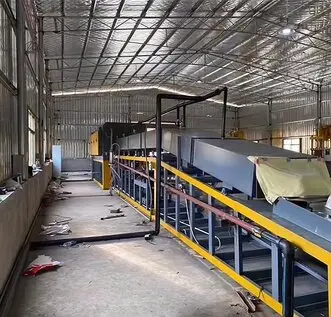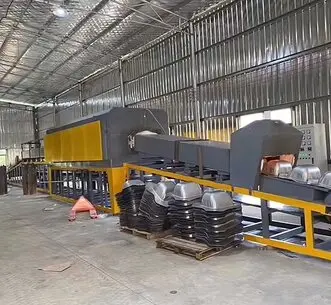In-depth Analysis of the Bright Annealing Furnace for Stainless Steel Bowls and Basins: Processes, Influences, and Applications
In the production field of stainless steel products, the bright annealing furnace for stainless steel bowls and basins plays a crucial and pivotal role. It is not only widely applied in the manufacturing process of stainless steel bowls and basins, having a decisive impact on the product's quality and performance, but also plays a key role in the high-precision processing of other stainless steel and metal products. Having an in-depth understanding of the heat treatment processes of the bright annealing furnace and their influences is of great significance for improving the quality and market competitiveness of stainless steel bowls.
During the processing of stainless steel bowls, internal stresses will accumulate, which pose a potential threat to their stability and durability. Through the annealing treatment in the bright annealing furnace, these internal stresses can be eliminated, significantly enhancing the dimensional stability of the stainless steel bowls and effectively preventing issues such as cracking or deformation during subsequent use. At the same time, the bright annealing furnace can make the metallographic structure of the stainless steel bowls and basins more uniform and refine the grains. This process not only improves the strength and toughness of the material but also greatly enhances its corrosion resistance, significantly extending the service life of the stainless steel bowls and basins. For some stainless steel bowls and basins with special requirements for hardness, heat treatment processes such as quenching in the bright annealing furnace can endow them with excellent wear resistance and scratch resistance, meeting the usage needs in different scenarios.
Bright annealing is one of the important applications of the bright annealing furnace in the surface treatment of stainless steel bowls and basins. Under a specific protective atmosphere, the stainless steel bowls and basins undergo bright annealing treatment, during which the oxide scale and impurities on the surface are removed, presenting the original bright luster of the metal. This bright surface is not only highly aesthetically pleasing but also meets food hygiene standards. It is easy to clean and not prone to staining, making it widely applicable to various catering places and households. In addition, the bright annealing furnace can also perform decarburization treatment, precisely controlling the carbon content on the surface of the stainless steel bowls and basins to avoid the occurrence of decarburization during the heat treatment process and ensuring that the surface quality and performance of the stainless steel bowls and basins are not affected.
If the heating rate is too fast, a large amount of thermal stress is likely to be generated inside the stainless steel bowls. Due to uneven heating of different parts of the bowl body, the expansion degrees are inconsistent, which may lead to deformation or even cracking of the bowl body. Conversely, if the heating rate is too slow, it will significantly prolong the production cycle and increase production costs. Moreover, prolonged low-temperature heating may cause excessive oxidation of the stainless steel surface, damaging the surface quality.
If the heating temperature is too low, the internal structure of the stainless steel cannot be fully homogenized, which is not conducive to performance improvement. Taking the solution treatment as an example, insufficient temperature will make it difficult for alloying elements to fully dissolve into the matrix, reducing the corrosion resistance and strength of the stainless steel. However, if the temperature is too high, it may cause the grains of the stainless steel bowls to grow excessively, reducing the toughness of the material, increasing energy consumption, and equipment wear. For stainless steel with a relatively high carbon content, an excessively high temperature may also cause a large amount of carbide precipitation, weakening the corrosion resistance.
If the holding time is too short, the internal structure of the stainless steel does not have enough time to fully transform and homogenize. For example, in the annealing treatment, insufficient holding time will lead to the incomplete elimination of internal stresses, affecting the dimensional stability and deformation resistance of the stainless steel bowls. On the contrary, if the holding time is too long, it will not only reduce production efficiency but also intensify the oxidation of the stainless steel surface, affecting the surface finish and corrosion resistance. It may even cause the grains to grow, reducing the comprehensive performance of the material.
If the cooling rate is too fast, a large amount of internal stress is likely to be generated inside the stainless steel bowls, which may lead to deformation or cracking of the bowl body. For example, during the quenching process, if the cooling rate is too fast, the martensitic transformation will be uneven, generating a large amount of structural stress. If the cooling rate is too slow, the structural transformation of the stainless steel will be incomplete, affecting its performance such as hardness, strength, and corrosion resistance. For example, during the cooling process after solution treatment, a too slow cooling rate will lead to the precipitation of alloying elements, reducing the corrosion resistance.
The bright annealing furnace usually uses a protective atmosphere to prevent the stainless steel bowls from oxidizing during the heat treatment process. If the composition or flow rate of the protective atmosphere is not properly controlled, it may not be able to effectively inhibit the oxidation reaction. For example, if the oxygen content in the protective gas is too high, an oxide scale will form on the surface of the stainless steel bowls, affecting the surface quality and appearance. Different protective atmospheres have different influences on the quality of stainless steel bowls. For example, if the purity of hydrogen is not sufficient, it may introduce impurities and affect the performance. When using nitrogen as the protective atmosphere, attention should be paid to the flow rate and pressure to ensure that it can evenly cover the surface of the stainless steel bowls and play a good protective role.

An appropriate heating temperature and sufficient holding time can ensure that alloying elements such as chromium and nickel are fully dissolved into the stainless steel matrix, forming a uniform solid solution, which can improve the electrode potential of the stainless steel and enhance its oxidation resistance and corrosion resistance. Conversely, if the temperature is too low or the holding time is insufficient, the alloying elements cannot be fully dissolved, and the corrosion resistance will decrease. At the same time, inappropriate heating temperature and holding time may also lead to the precipitation of carbides. When heated for a long time within the sensitization temperature range (generally 450 - 850°C), the carbon in the stainless steel will combine with chromium to form chromium carbide, which precipitates along the grain boundaries. This will reduce the chromium content near the grain boundaries, forming a chromium-depleted zone and reducing the intergranular corrosion resistance.
The martensitic or bainitic structures obtained through rapid cooling may have a large amount of internal stress and an unstable phase structure, which may affect the corrosion resistance under certain conditions. On the other hand, slow cooling is conducive to obtaining a stable ferritic or austenitic structure, with good structural uniformity and higher corrosion resistance. In addition, the cooling rate will affect the distribution of alloying elements. When the cooling rate is fast, the alloying elements do not have enough time to fully diffuse, which may form a local concentration gradient, resulting in an uneven structure. In a corrosive environment, it is easy to form microcells, accelerating the corrosion process. An appropriate cooling rate can make the alloying elements evenly distributed, improving the corrosion resistance.

Protective atmospheres such as nitrogen and hydrogen can prevent the stainless steel bowls from oxidizing due to contact with oxygen during the heat treatment. If the protective atmosphere is insufficient or the purity is not enough, the formed oxide film will not be dense, and it cannot effectively block the contact between external media and the metal matrix, reducing the corrosion resistance. The components in the protective atmosphere may also react with the surface of the stainless steel, affecting the surface chemical composition and structure. For example, under certain conditions, hydrogen can reduce some elements on the surface of the stainless steel, changing the structure of the passive film to make it more dense and stable, thus improving the corrosion resistance. However, if the atmosphere control is not proper, it may introduce impurities or lead to an uneven surface composition, instead reducing the corrosion resistance.
The heat treatment processes of the bright annealing furnace for stainless steel bowls are a complex and precise system. From the application fields to the influences on product quality and corrosion resistance, every link is interrelated and influences each other. Only by accurately grasping these process key points can production enterprises produce high-quality, high-performance, and corrosion-resistant stainless steel bowls, meet the increasingly diverse needs of the market, and gain an advantage in the fierce market competition.
BAI KA Copyright © 2025 ALL rights reserved